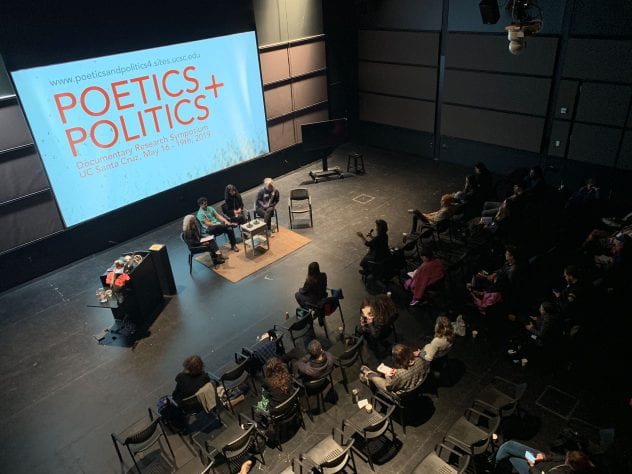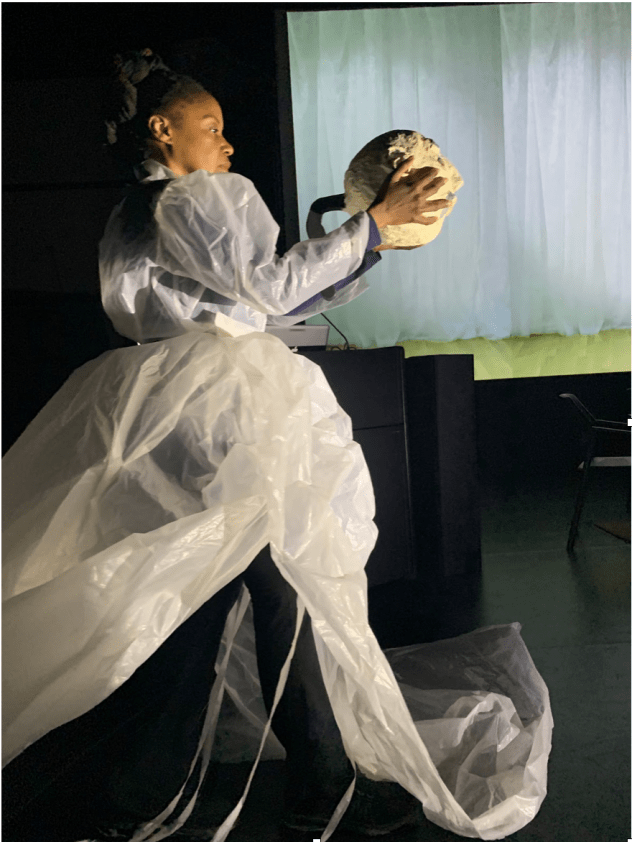SYMPOSIUM REVIEW: POETICS AND POLITICS 4 “AGAINST STORY”
Hannah Payne
Porter 61
In the fourth iteration of the biennial Poetics and Politics Symposium questions of the immediacy of story in documentary practice were brought to the forefront. Co-organized and co-curated by Irene Gustafson and Irene Lusztig, the four-day event integrated screenings, conversation, and criticism reticulated around the theme “Against Story,” inspired by Alexandra Juhasz and Alisa Lebow’s critical online manifesto “Beyond Story.” This manifesto, taken with the more combative theme of “Against Story,” provided a foundation for the multi-day discussion around story and its significance in documentary practice, as well as a network of related topics such as world-building, polyvocality, and opacity. This event was organized into thirteen sessions divided across the four days, with two keynote speakers, and three ‘breakout sessions’ in which the schedule split into parallel sessions with attendees given the choice of which to attend. The use of parallel panels allowed conversations to combine and permute based on individual topics, and in the evening sessions, when the group reconvened together in one room, the ensuing questions and discussions reflected this. Each session (with the exception of Session 6, a preview screening of Sarah Christman’s feature-length documentary, Swarm Season) consisted of several people presenting their recent or in-progress work, grouped together by their shared practice, topic, or concern. Each session ended with a moderated question and answer section, and often these questions directly provoked a discussion in line with the larger questions of the symposium.
Thursday evening’s welcome introduced the theme of the symposium, included a panel on framing story and practice, and even allowed space for organizers of a local labor union to speak about their struggles with the hostile work environment created by the University of California institution. This last inclusion seemed to foreshadow an underlying thread of discussion that persisted throughout the symposium: how established narratives of colonization, documentary history and practice, and social and political struggle still exist and have power in the world. This political undercurrent came to the surface multiple times each day of the symposium, and represents, to this attendee, the political and psychological strength of story, and thus, the ethical ramifications of trivializing its power. Even when conversations became heated in the course of the symposium, these were reactions to the fundamentally political notion of story.
Lana Lin, the first keynote speaker, provided a framework for several important ideas that would become complementary topics to the theme of “Against Story.” In her presentation, she suggested the other half of the symposium’s title, poetics, as a means of rejecting story in the creation of work. During her presentation, she screened excerpts from her most recent feature film, The Cancer Journals Revisited, a work she referred to as “poetic nonfiction.” The film rejects narrative in multiple ways: the central focus, Audre Lorde’s The Cancer Journals, is a work that rejects the traditional memoir form, and the film itself employs polyvocality and resists the narrative satisfaction that surrounds illness narratives. The poetic takes precedence over narrative. Her keynote brought up a number of topics that remained relevant over the course of the symposium, especially notions of form, identity, collective voice and polyvocality, and opacity.
Due to the amount of work and discussions surrounding story presented in this symposium, this review will also mention the highlights of the symposium as a whole. On the first full day, one of the final sessions was focused on documentary work about animals and how story shapes these works. Not only was this interesting due to the fact that animal and nature documentaries are the most financially lucrative in the documentary market, but also because of the relatively obvious way in which story is imposed onto non-human beings and landscapes through anthropomorphism. During this panel, the alternatives to anthropomorphization were also complicated through the idea that a certain visual approach that avoids anthropomorphism does not necessarily denote anti-narrative politics, ultimately urging critical thought and practice around presenting non-human subjects in relation to story. Another highlight was the performance of “She Who Is” (part of the Embodied Stories session on Saturday) a work in progress that is thinking critically about form, biography, performance, and collaboration in a beautiful and fascinating way. “She Who Is” used a combination of live performance and screening, and focused on overlooked text, like stage directions, to find new meanings, and ended up feeling like it was in poetic dialogue with Lana Lin’s work. Lastly, Saturday’s Time Travel session screenings of three short films provided a moment to truly think about story in relation to practice. Two of the three screenings were in progress and constituted an opportunity to linger on how one can subvert story in the act of filmmaking. In particular, The Eddies used performance and artifice in an interesting and poetic way to subvert narrative while incisively diving into issues of masculinity in America. Compared to the tone of some of the other work shown at the symposium that could be overly pedantic, The Eddies was like a breath of fresh, creative air that still was doing critical work around story.
Kirsten Johnson, the second keynote, spoke on the navigating the visual space of filming in the modern era when many people have access to cameras and images of themselves. As a cinematographer working in the documentary world for multiple decades, she brought a unique perspective on the act of filming and being seen. She made the point that an image can represent a relationship and that due to changing technology and greater access to technology, people now have more agency in the act of being filmed. She also pointed to the simultaneous proliferation of images and meteoric increase in surveillance, where people have no control over being seen. However, she seemed interested in the act of filming but not the ethics of the act of filming, nor how that act of filming and the history and power dynamics it carries with it is the result of colonization and institutional racism.
The issues of Kirsten Johnson’s keynote are representative of the issues of the symposium on the whole. Though there were many moments of collaborative and critical discussion about the implications that story has on documentary work and documentary’s relationship with histories of colonization and institutional racism, there were many moments where there seemed to be a lack of desire for critically examining work and practices. The manifesto, “Beyond Story,” seemed to come from a place of concern over documentary ethics and social justice in the realm of story, yet these topics seemed ignored or unheard of by some attendees and participants. There were many good conversations, but there was almost a willful neglect of critical self-analysis and analyses of others’ work. For example, people did not want to talk about the potential ethical issues with Sarah Christman going to Hawaii to shoot Swarm Season as a non-native, non-Hawaiian white woman, they wanted to talk about how she achieved her sound design. I believe a conference setting should be a space of criticism, conversation, and confrontation that leads to greater understandings moving forward, not a space of confirmation of status. I hope the next Poetics and Politics learns from the successes and issues of this iteration and opens up further as a space of critical practice and exploration.

